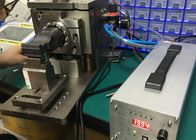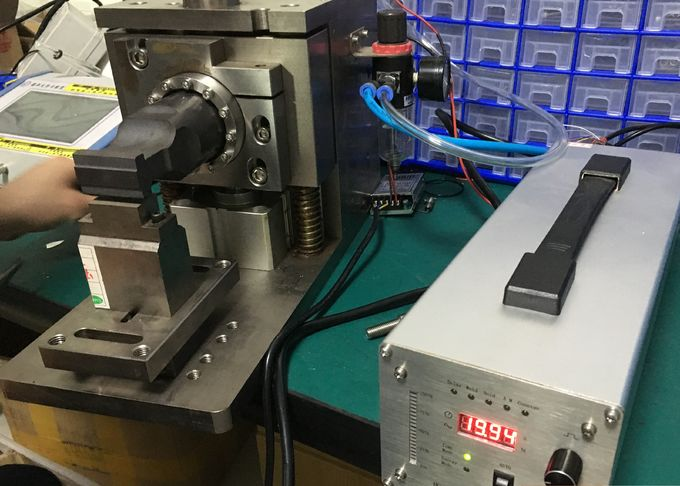
loading


| Quantity: | |
| Place of Origin | China |
|---|---|
| Brand Name | RPS-SONIC |
| Certification | CE |
| Model Number | RPS-2010GL |
| Minimum Order Quantity | 1set |
| Price | negotiation |
| Packaging Details | FOAM AND CARTON |
| Delivery Time | 3DAYS |
| Payment Terms | T/T, Western Union, MoneyGram |
| Supply Ability | 200 SETS PER MONTH |
| Frequency | 20Khz | Power | 800w |
|---|---|---|---|
| Type | Digital Generator | Application | Tinning |
| Temperature Range | 200~400 °C | Horn | Alloy Steel |
| High Light | ultrasonic soldering machine,ultrasonic soldering station | ||
Flux Free Ultrasonic Soldering Equipment Of Aluminum Stainless Or Ceramic Tinning
Ultrasonic Soldering Machine ( Dip Soldering Type ) offers highly solid and reliable soldering joints without flux.
There are two main reasons for using Ultrasonic Soldering:
1. To eliminate the need for flux in the soldering process
2. To apply solder to ceramics and similar materials
The advantages of removing flux from the process are that there is no need for post-process
cleaning and wicking caused by surface tension from the flux is removed. Eliminating post-process
cleaning has the obvious benefit of cost saving for both the process and the flux itself. The benefit of
eliminating wicking is that the solder coating on the base material can be better controlled.
The ultrasonic tinning equipment consists of a solder bath, solder temperature controller, ultrasonic generator and
ultrasonic probe. There is also the option of an automatic dross removal system. The probe is
partially submerged in the solder providing the ultrasonic frequency to the work piece dipped in the
solder. The solder temperature controller has a thermocouple to the solder bath to monitor
temperature and adjust the heaters accordingly. The ultrasonic tinning equipment is best suited to dip tinning and
soldering applications.
Application
Description
| Model No. | RPS-2010GL |
| Ultrasonic Frequency | 20 KHz ± 1 KHz |
| Maximum Output | 800Watt |
| Temperature Range | 200 ~ 400 °C |
| Power Supply | 220V ( Single Phase) / 50-60 Hz |
| Horn | alloy steel |
| Generator | Digital generator |
| Features | |
|
· Full Dgital Control · Ultrasonic Amplitude Adjustable : 10 ~ 100% · Auto Frequency Tuning : 20 kHz +/- 1 kHz · Programmable Welding Time and Energy (10 memories for welding condition) · Ultrasonic Load Meter Scale · Soldering prod Full Diucts manually · No Flux soldering | |
Benefits and Applications
Ultrasonic energy introduced into a dip solder pot eliminates the need for flux while enhancing many soldering processes. It also provides a means to bond solder to a number of materials including aluminum and glass that are difficult or impossible to solder using conventional soldering techniques. RPS-sonic has perfected a technique for introducing ultrasonic energy into dip solder pots and is the exclusive manufacturer of this type of equipment in the world today.
RPS-SONIC' solder pots are activated by externally mounted transducers which allow large volume multi-part dipping. The systems' controls are adaptable to automated lines.
Electronic Component Tinning and Soldering
A process for tinning plated wire involves first the placing of the wire in a suitable chemical flux for a period of time, the wire is then immersed for a period of time into a static solder pot having molten solder therein, the wire is then re-immersed into the chemical flux for a period of time, and finally the wire is immersed for a period of time into an ultrasonic solder pot having molten solder therein, the wire when removed from the ultrasonic pot being sufficiently tinned such that the solder has formed a suitable intermolecular bond to the plating in accordance with typical bonding criteria.
Component lead solderability is a major consideration when devices are to be incorporated into high reliability hardware such as that used by the military, human implants including pacemakers and defibrillators, and for aerospace applications. This is especially true in cases where the device, once installed, is not accessible for service. In these critical applications it is commonplace to "tin" component leads when they arrive at the assembly house and prior to going into storage. In some cases the component leads may again be "tinned" immediately prior to use. Ultrasonic tinning offers several advantages over conventional flux methods for high reliability lead tinning.
The ultrasonic soldering process does not use flux. Ultrasonic cavitation and implosion provide the mechanism to mechanically remove surface oxides to allow solder adhesion to take place. Since there is no flux used, there is no chance of solder splatter or the inclusion of flux or flux decomposition byproducts in the solder coating. The necessity to remove flux residues after soldering is also eliminated.
Since there is no flux, there is no "wicking" of solder above the solder level. This means that solder will not wick into stranded wires or into connector contacts.
The ultrasonic soldering process excels in the removal of protective gold, silver, and other platings from lead surfaces. Military and NASA specifications recommend ultrasonic soldering for gold removal.
Ultrasonic tinning has been successful in restoring the solderability of component leads that could not be recovered using the fluxes allowed by military and other specifications. The vigorous mechanical scrubbing provided by ultrasonic energy surpasses many other mechanical recovery techniques.

| Frequency | 20Khz | Power | 800w |
|---|---|---|---|
| Type | Digital Generator | Application | Tinning |
| Temperature Range | 200~400 °C | Horn | Alloy Steel |
| High Light | ultrasonic soldering machine,ultrasonic soldering station | ||
Flux Free Ultrasonic Soldering Equipment Of Aluminum Stainless Or Ceramic Tinning
Ultrasonic Soldering Machine ( Dip Soldering Type ) offers highly solid and reliable soldering joints without flux.
There are two main reasons for using Ultrasonic Soldering:
1. To eliminate the need for flux in the soldering process
2. To apply solder to ceramics and similar materials
The advantages of removing flux from the process are that there is no need for post-process
cleaning and wicking caused by surface tension from the flux is removed. Eliminating post-process
cleaning has the obvious benefit of cost saving for both the process and the flux itself. The benefit of
eliminating wicking is that the solder coating on the base material can be better controlled.
The ultrasonic tinning equipment consists of a solder bath, solder temperature controller, ultrasonic generator and
ultrasonic probe. There is also the option of an automatic dross removal system. The probe is
partially submerged in the solder providing the ultrasonic frequency to the work piece dipped in the
solder. The solder temperature controller has a thermocouple to the solder bath to monitor
temperature and adjust the heaters accordingly. The ultrasonic tinning equipment is best suited to dip tinning and
soldering applications.
Application
Description
| Model No. | RPS-2010GL |
| Ultrasonic Frequency | 20 KHz ± 1 KHz |
| Maximum Output | 800Watt |
| Temperature Range | 200 ~ 400 °C |
| Power Supply | 220V ( Single Phase) / 50-60 Hz |
| Horn | alloy steel |
| Generator | Digital generator |
| Features | |
|
· Full Dgital Control · Ultrasonic Amplitude Adjustable : 10 ~ 100% · Auto Frequency Tuning : 20 kHz +/- 1 kHz · Programmable Welding Time and Energy (10 memories for welding condition) · Ultrasonic Load Meter Scale · Soldering prod Full Diucts manually · No Flux soldering | |
Benefits and Applications
Ultrasonic energy introduced into a dip solder pot eliminates the need for flux while enhancing many soldering processes. It also provides a means to bond solder to a number of materials including aluminum and glass that are difficult or impossible to solder using conventional soldering techniques. RPS-sonic has perfected a technique for introducing ultrasonic energy into dip solder pots and is the exclusive manufacturer of this type of equipment in the world today.
RPS-SONIC' solder pots are activated by externally mounted transducers which allow large volume multi-part dipping. The systems' controls are adaptable to automated lines.
Electronic Component Tinning and Soldering
A process for tinning plated wire involves first the placing of the wire in a suitable chemical flux for a period of time, the wire is then immersed for a period of time into a static solder pot having molten solder therein, the wire is then re-immersed into the chemical flux for a period of time, and finally the wire is immersed for a period of time into an ultrasonic solder pot having molten solder therein, the wire when removed from the ultrasonic pot being sufficiently tinned such that the solder has formed a suitable intermolecular bond to the plating in accordance with typical bonding criteria.
Component lead solderability is a major consideration when devices are to be incorporated into high reliability hardware such as that used by the military, human implants including pacemakers and defibrillators, and for aerospace applications. This is especially true in cases where the device, once installed, is not accessible for service. In these critical applications it is commonplace to "tin" component leads when they arrive at the assembly house and prior to going into storage. In some cases the component leads may again be "tinned" immediately prior to use. Ultrasonic tinning offers several advantages over conventional flux methods for high reliability lead tinning.
The ultrasonic soldering process does not use flux. Ultrasonic cavitation and implosion provide the mechanism to mechanically remove surface oxides to allow solder adhesion to take place. Since there is no flux used, there is no chance of solder splatter or the inclusion of flux or flux decomposition byproducts in the solder coating. The necessity to remove flux residues after soldering is also eliminated.
Since there is no flux, there is no "wicking" of solder above the solder level. This means that solder will not wick into stranded wires or into connector contacts.
The ultrasonic soldering process excels in the removal of protective gold, silver, and other platings from lead surfaces. Military and NASA specifications recommend ultrasonic soldering for gold removal.
Ultrasonic tinning has been successful in restoring the solderability of component leads that could not be recovered using the fluxes allowed by military and other specifications. The vigorous mechanical scrubbing provided by ultrasonic energy surpasses many other mechanical recovery techniques.









Ultrasonic Welding Equipment Ultrasonic Welding Transducer Ultrasonic Welding Converter Ultrasonic Liquid Processor Ultrasonic Cutting Equipment Ultrasonic Spray Nozzles Ultrasonic Power Supply Ultrasonic Soldering Equipment Ultrasonic Welding Horn Ultrasonic Assisted Machining Ultrasonic Testing Equipment
content is empty!